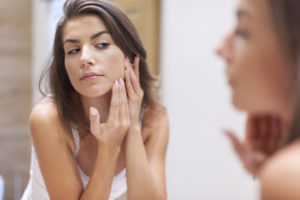 Think your teenager is confident? Just tell him or her an acne breakout is eminent. “What? Where? What do you see. Eek!” This could be followed by the door closing to the bedroom, only to be opened when said breakout has passed.
Think your teenager is confident? Just tell him or her an acne breakout is eminent. “What? Where? What do you see. Eek!” This could be followed by the door closing to the bedroom, only to be opened when said breakout has passed.
Ah, acne, the bane of pretty much every teenager. But acne treatment has come a long way, so there’s no need for your teenager to suffer as much as you may have when you were a breakout-prone high school student. Dr. Kronberg has various treatment approaches to address your teen’s acne issues. Each treatment is personalized to the individual situation.
What causes acne?
Everyone still thinks eating one too many chocolate bars or potato chips leads to acne. Nope.
Acne is basically caused by the sebaceous glands. These are the glands that produce the oil that keeps our skin and hair moist. Most sebaceous glands are attached to the hair follicles. Unfortunately, during puberty, when teenage hormones are off the charts the sebaceous glands overproduce oil. This overproduction means that the oil can’t leave the follicle fast enough and it clogs. Now that clogged follicle is a prime spot for bacteria to accumulate and thrive. It’s thought that the chemical breakdown of triglycerides in the sebum releases fatty acids that trigger an inflammatory response. This irritation shows itself in pimples and other blemishes. Like most things, there are degrees of acne from mild to extreme, plus some forms of acne can cause permanent scarring.
Different types of acne, different treatments
Most cases of acne fit into three categories: comedonal, inflammatory, and cystic. Comedal acne is generally mild and can be addressed with over-the-counter products and practices such as simply washing your face diligently. Inflammatory and cystic acne are more serious and demand more aggressive treatment. These will usually involve prescription topical applications, retinoids, even antibiotics. Oral antibiotics such as doxycycline, tetracycline, minocycline, or erythromycin kill the bacteria in the clogged sebaceous glands, reducing the inflammation.
How Dr. Kronberg treats acne
Dr. Kronberg personalizes every acne treatment to the patient, depending on factors listed above and other issues.
Mild acne — In cases of mild, usually comedal acne, Dr. Kronberg can recommend products that help clear things out. These will usually contain benzoyl peroxide or salicylic acid. They don’t work overnight, but in a month or two will show real improvement.
Moderate to severe acne — This requires attention to keep the acne from causing scarring and to lessen the severity of breakouts. Topical treatments usually go after the bacteria that have accumulated in the clogged follicles. Others seek to reduce the overproduction of oil that is causing the clogging. These products may include the same ingredients used on mild acne, only in prescription dosages.
She may prescribe antibiotics to kill the bacteria and reduce inflammation, particularly in cases of cystic acne. Isotretinoin (also sometimes known by the brand name Accutane) is a presciption treatment that is effective for all types of acne, but is usually only used in severe cases. It restricts the body’s ability to produce natural oils.
Beyond medications, Dr. Kronberg uses these methods:
- Lasers and light therapy — These devices use light that target and kill the p.acnes bacteria, reducing inflammation. Dr. Kronberg uses both the N-Lite and Regenlite lasers for these treatments.
- Chemical peels — Chemical peels, usually salicylic acid-based, remove dead skin cells, open clogged pores, reduce oils, and improve the skin’s texture and surface composition.
There’s no need for your teenager to deal with the embarrassment of acne. Call Dr. Kronberg at 713-771-8941 today and let’s get to work clearing your teenager’s skin.





No comments yet.